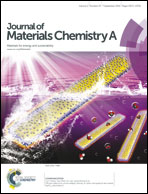Towards new generation fuel cell electrocatalysts based on xerogel–nanofiber carbon composites
Abstract
Xerogel–nanofiber carbon composites (XNCCs) have been easily synthesized by using a Ni catalyst supported on carbon xerogel (CXG), growing randomly oriented carbon nanofibers (CNFs) within the coralline-like structure of the xerogel (CXG). This novel composite combines the advantages of xerogel and fiber nanostructures. The interactions between these phases as well as their effect as a support on Pt electrocatalysts for the oxygen reduction reaction (ORR) have been investigated. Platinum catalysts supported on different XNCCs (varying in terms of CXG and CNF contents) as well as on bare CXG and CNFs have been synthesized using a microemulsion route. They have been characterized in terms of structure, morphology and porosity and investigated for the ORR in a half-cell configuration. The catalyst supported on the XNCC with a 44% CNF content shows the best electrochemical behavior. This catalyst formulation leads to a catalytic activity 5 times higher than that obtained on a Vulcan-based catalyst at low overpotential and 2.5 times higher at large overpotential. Accelerated degradation tests also show better stability for the composite support-based catalyst. Compared to bare CNF and CXG supports, a stabilization effect is envisaged by the presence of highly graphitic CNFs within the composite structure.


 Please wait while we load your content...
Please wait while we load your content...